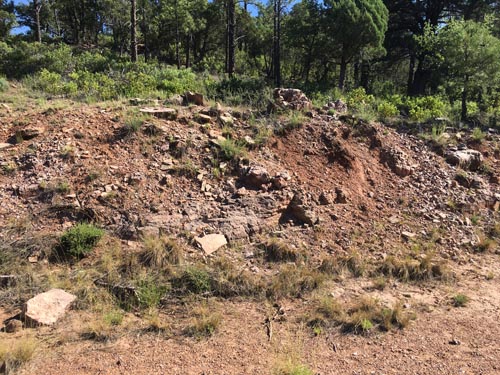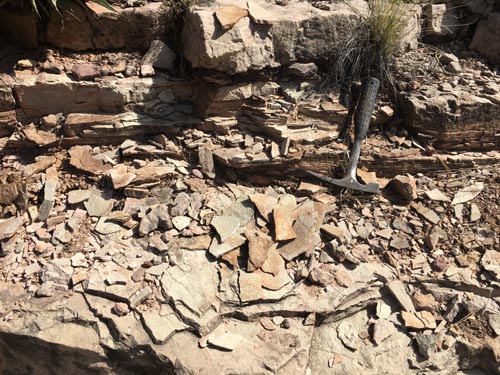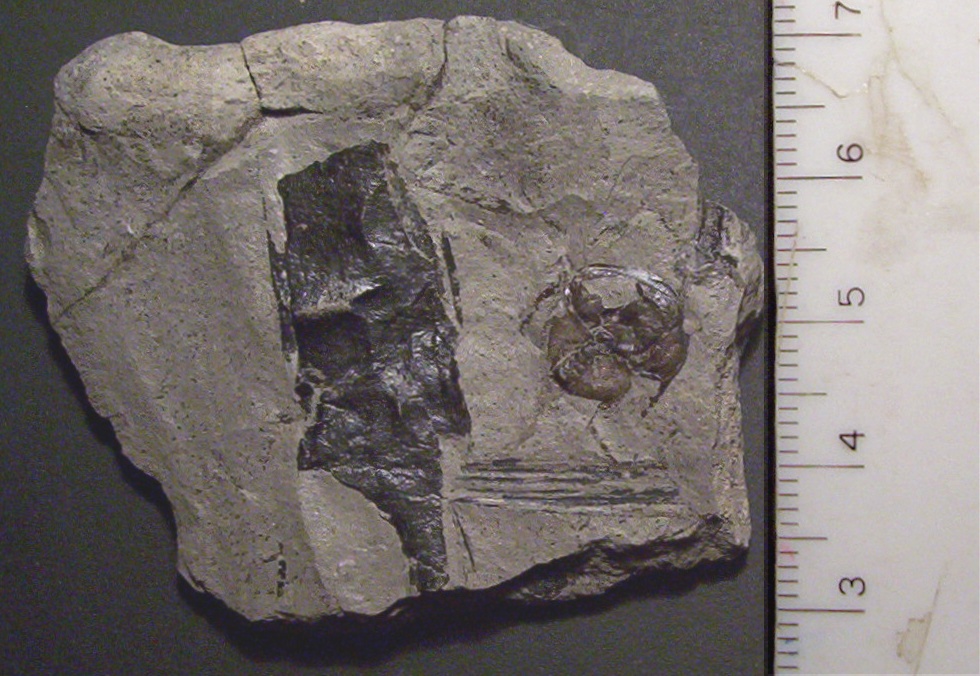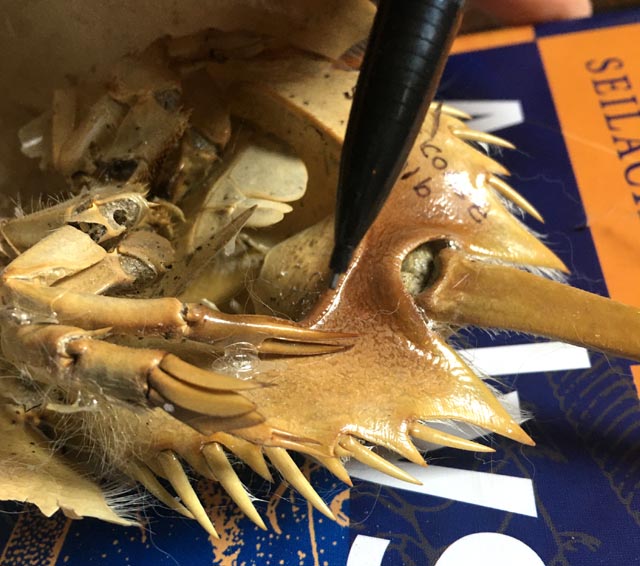 The Outcrop is about 150 feet long.
(Center portion here)
The Outcrop is about 150 feet long.
(Center portion here)
|
Limulid
(Horseshoe Crab) Trace Fossils
in the Pennsylvanian
Naco Formation
|
 Here is the mud stone / shale bed where
the tracks and trackways are found.
Here is the mud stone / shale bed where
the tracks and trackways are found.
|

Above: Collection of classic Limulid tracks from this unique locality.
|
Updated 6/20/20
 |
Introduction
This site is unique
- No where else in Arizona have we found Pennsylvanian aged Kauphichium
trace fossils. And there are a LOT of trace fossil localities
in the Naco formation. We discovered this site about 10 years
ago from searching satellite photos of the area looking for promising
outcrops. On an abandoned side road leading to nowhere, we spotted
a small outcrop at a road fill site, with apparently very fine
laminar layers. We then drove our 4WD to this site, not far off
the main highway, and were astounded at how thin and muddy the
layers were. Expecting to find Composita Brachiopods, or perhaps
Encrinus Crinoid material, we were initially very disappointed
to find no body fossils of any type.
Then we started splitting
the layers one by one, and found something we had never seen
before in the Naco around Payson - Wave ripples. Then we found
fossilized mud cracks. And it got better. Large numbers of very
small finely detailed tracks and under tracks of arthropods!
We collected representive fossils for hours and took them home
to see under magnification exactly what was present. There we
discovered hordes of Kauphichnium undertracks, hard ground surface
tracks, and lines of trackways, many with carapace drags along
side them. This was a site like no other. No burrows, gastropod
traces (Aulichnites) or any other type of trace fossils we find
commonly in the Naco. Here we had a shallow water environment,
with thin layers of mudstone - not the pure limestone we always
have found in this formation.
But the story does
not end there - Just down the road at an abandoned quarry our
friend Rik Hill discovered a few years before a Limulid known
as Euproops sp. which is exactly the size to make such a small
trackway. The story now was complete, we had the trackways and
the body fossils from Pennsylvanian stata in the same basic area.
|
 | This
is the Euproops sp. that Rik found (Right side of slab) in the
Pennsylvanian / Permian shales down the road. It is very well
preserved and the right size for making those tiny little trackways
we found. Click to enlarge. |

| From
the Treatise on Invertebrate Paleontology, volume W. This shows
the typical "Y" shaped prints made from the middle
and front leg claws on a Limulid. The last pair of legs is specially
modified to make a triple bladed "Pusher" which leaves
the peculiar fork shaped pattern. Many of the under prints are
from the pushers since they compress the soil more deeply forming
undertracks. |

| This
is a horseshoe crab I found dead lying on the shore in Florida
a few years ago when we ran the Space Coast Marathon. It shows
the bifurcated standard claw tips which make the Y shaped impressions,
and just below, the three bladed Pusher leg which produces the
under tracks. |
|

From Seilachers monumental
book on Trace Fossils (Trace Fossil Analysis), this set of images
shows the typical appearance of under prints and tracks. They
are slot like or round pincher tips which probed more deeply
into the mud and are only visible when the upper most layers
are worn away, or in our case were in the layers above where
the shales split.
|
Fossil images:
Below - These images were taken with a point like high power LED lamp at a low angle to emphasize the trace fossils.
A Canon 10D with a 150mm Macro lens was used to take these images at high resolution. The average size of these
slabs is around 60mm, and the fossils are very small. The lighting angle is always critical with trace fossils, just turning
the fossil 90 degrees can make them fade from view. This has to be utilized in the field while collecting to be able
to see anything at all. Forget cloudy days!
Small trackway of both round and slotted undertracks preserved as negative epireliefs. I will mark the tracks after the first
two images here so you can see them more clearly.
 Below: Close up of one slot shaped underprint showing its crescent profile. These are the most common finds here.
Below: Close up of one slot shaped underprint showing its crescent profile. These are the most common finds here.
 Below: Numerous small underprints and a possible telson drag underprint.
Below: Numerous small underprints and a possible telson drag underprint.
 Below: These underprints are much closer to the actual hardground surface - the slots are sharper and you can see
the "Y" shaped print on the left a more classic Kauphichnium print.
Below: These underprints are much closer to the actual hardground surface - the slots are sharper and you can see
the "Y" shaped print on the left a more classic Kauphichnium print.
 Below: Wider view of same slab showing many sharp prints. Notice the assemblage of small round prints to the
lower left, these are the round types from the crab "tip toeing" around.
Below: Wider view of same slab showing many sharp prints. Notice the assemblage of small round prints to the
lower left, these are the round types from the crab "tip toeing" around.
 Below: Another Y shaped print from one of the front legs.
Below: Another Y shaped print from one of the front legs.
 Below: Many of the slabs have the prints aligned in one direction.
Below: Many of the slabs have the prints aligned in one direction.
 Below:Close up of another Y shaped print. These are very diagnostic!
Below:Close up of another Y shaped print. These are very diagnostic!
 Below: Many of the slabs had interesting drag marks on them. They may correspond to tooling marks (non
biological drags) or in many cases is carapace drag marks from various spines on the sides of the animal.
Below: Many of the slabs had interesting drag marks on them. They may correspond to tooling marks (non
biological drags) or in many cases is carapace drag marks from various spines on the sides of the animal.
 Below: Another fine little slab with some Y shaped and slotted details.
Below: Another fine little slab with some Y shaped and slotted details.
 Below: A beautiful Y shaped print along with many underprints on a small 2 inch slab. Note the prints STICK OUT
here. This is an in fill on the bottom of the slab and is classified as a positive hyporelief.
Below: A beautiful Y shaped print along with many underprints on a small 2 inch slab. Note the prints STICK OUT
here. This is an in fill on the bottom of the slab and is classified as a positive hyporelief.
 Below: Close up of the really nice Y shaped hyprorelief print.
Below: Close up of the really nice Y shaped hyprorelief print.
 Below: Now back to the more common negative epirelief underprints. This slab is very busy, no doubt the limulids
were have a dance party here.
Below: Now back to the more common negative epirelief underprints. This slab is very busy, no doubt the limulids
were have a dance party here.
 Below: Nice underprint trackway sequence.
Below: Nice underprint trackway sequence.
 Below: One of the most amazing finds for preservation. This is very near the surface of the hardground, and shows
sharp details in the Y shaped prints (3 of them in a group) and some of the slotted and point type impressions.
Below: One of the most amazing finds for preservation. This is very near the surface of the hardground, and shows
sharp details in the Y shaped prints (3 of them in a group) and some of the slotted and point type impressions.
 Below: Close up of the very nice Y shaped Kauphichnium prints.
Below: Close up of the very nice Y shaped Kauphichnium prints.
 Below: A few tracks and partial trackway going in different directions.
Below: A few tracks and partial trackway going in different directions.
 Below: An obvious short trackway of under prints. So this would be called an "Under Track"
Below: An obvious short trackway of under prints. So this would be called an "Under Track"
 Below: Two trackways on a small slab.
Below: Two trackways on a small slab.
 Below: Three linear tracks on the right, and a few isolated prints elsewhere.
Below: Three linear tracks on the right, and a few isolated prints elsewhere.
 Below: I can see possibly three distinct trackways here on this larger slab.
Below: I can see possibly three distinct trackways here on this larger slab.
 Below: A most peculiar slab, showing what appears to be more spine / carapace drag impressions. We see lots of these
associated with trackways, but sometimes we find the carapace drags with little or no feet impressions.
Below: A most peculiar slab, showing what appears to be more spine / carapace drag impressions. We see lots of these
associated with trackways, but sometimes we find the carapace drags with little or no feet impressions.
 Below: A few nice carapace drags mixed in with the prints. They could also possibly be dragging their feet tips as well.
Below: A few nice carapace drags mixed in with the prints. They could also possibly be dragging their feet tips as well.
 Below: A horseshoe crab superhighway! Besides the killer trackway on the left with telson drag, the right side is
loaded with many round prints.
Below: A horseshoe crab superhighway! Besides the killer trackway on the left with telson drag, the right side is
loaded with many round prints.
 Below: Small partial trackway. Id love to find a slab of some size with a nice long trackway....
Below: Small partial trackway. Id love to find a slab of some size with a nice long trackway....
 Below: Misc small prints and drag marks.
Below: Misc small prints and drag marks.
 Below: A rough Y shaped imprint in the center, and several other sharp tracks.
Below: A rough Y shaped imprint in the center, and several other sharp tracks.
 Below: Tracks, some faint drag marks from possibly the telson (the spine on the back of a horseshoe crab).
Below: Tracks, some faint drag marks from possibly the telson (the spine on the back of a horseshoe crab).
 Below: Two sets of round tip toe impressions. Positive hyporelief.
Below: Two sets of round tip toe impressions. Positive hyporelief.
 Below: Long trackway on a big slab.
Below: Long trackway on a big slab.
 Below: Close up of Y shaped central track, again key to identifying the track producer.
Below: Close up of Y shaped central track, again key to identifying the track producer.
 Below: Closer view.
Below: Closer view.

|
Conclusions.
Conditions have to
be perfect to see such tracks in the field. Helpful are magnifiers
you wear on your head that can flip down when needed such as
an Optivisor. The sun must be out and no clouds dimming it. Then
and only then can you find such fossils. This is the only site
we have ever found in the Naco with Limulid traces. In other
parts of Arizona, we have found Limulid tracks in the Permian
Hermit Shale, and in the Supai Formation in the Grand Canyon
on Kaibab trail. They are usually quite a bit larger in size,
but have the same exact physical morphology of these diminutive
specimens.
|

Paleo HOME
|
 Below: Close up of one slot shaped underprint showing its crescent profile. These are the most common finds here.
Below: Close up of one slot shaped underprint showing its crescent profile. These are the most common finds here.
 Below: Numerous small underprints and a possible telson drag underprint.
Below: Numerous small underprints and a possible telson drag underprint.
 Below: These underprints are much closer to the actual hardground surface - the slots are sharper and you can see
the "Y" shaped print on the left a more classic Kauphichnium print.
Below: These underprints are much closer to the actual hardground surface - the slots are sharper and you can see
the "Y" shaped print on the left a more classic Kauphichnium print.
 Below: Wider view of same slab showing many sharp prints. Notice the assemblage of small round prints to the
lower left, these are the round types from the crab "tip toeing" around.
Below: Wider view of same slab showing many sharp prints. Notice the assemblage of small round prints to the
lower left, these are the round types from the crab "tip toeing" around.
 Below: Another Y shaped print from one of the front legs.
Below: Another Y shaped print from one of the front legs.
 Below: Many of the slabs have the prints aligned in one direction.
Below: Many of the slabs have the prints aligned in one direction.
 Below:Close up of another Y shaped print. These are very diagnostic!
Below:Close up of another Y shaped print. These are very diagnostic!
 Below: Many of the slabs had interesting drag marks on them. They may correspond to tooling marks (non
biological drags) or in many cases is carapace drag marks from various spines on the sides of the animal.
Below: Many of the slabs had interesting drag marks on them. They may correspond to tooling marks (non
biological drags) or in many cases is carapace drag marks from various spines on the sides of the animal.
 Below: Another fine little slab with some Y shaped and slotted details.
Below: Another fine little slab with some Y shaped and slotted details.
 Below: A beautiful Y shaped print along with many underprints on a small 2 inch slab. Note the prints STICK OUT
here. This is an in fill on the bottom of the slab and is classified as a positive hyporelief.
Below: A beautiful Y shaped print along with many underprints on a small 2 inch slab. Note the prints STICK OUT
here. This is an in fill on the bottom of the slab and is classified as a positive hyporelief.
 Below: Close up of the really nice Y shaped hyprorelief print.
Below: Close up of the really nice Y shaped hyprorelief print.
 Below: Now back to the more common negative epirelief underprints. This slab is very busy, no doubt the limulids
were have a dance party here.
Below: Now back to the more common negative epirelief underprints. This slab is very busy, no doubt the limulids
were have a dance party here.
 Below: Nice underprint trackway sequence.
Below: Nice underprint trackway sequence.
 Below: One of the most amazing finds for preservation. This is very near the surface of the hardground, and shows
sharp details in the Y shaped prints (3 of them in a group) and some of the slotted and point type impressions.
Below: One of the most amazing finds for preservation. This is very near the surface of the hardground, and shows
sharp details in the Y shaped prints (3 of them in a group) and some of the slotted and point type impressions.
 Below: Close up of the very nice Y shaped Kauphichnium prints.
Below: Close up of the very nice Y shaped Kauphichnium prints.
 Below: A few tracks and partial trackway going in different directions.
Below: A few tracks and partial trackway going in different directions.
 Below: An obvious short trackway of under prints. So this would be called an "Under Track"
Below: An obvious short trackway of under prints. So this would be called an "Under Track"
 Below: Two trackways on a small slab.
Below: Two trackways on a small slab.
 Below: Three linear tracks on the right, and a few isolated prints elsewhere.
Below: Three linear tracks on the right, and a few isolated prints elsewhere.
 Below: I can see possibly three distinct trackways here on this larger slab.
Below: I can see possibly three distinct trackways here on this larger slab.
 Below: A most peculiar slab, showing what appears to be more spine / carapace drag impressions. We see lots of these
associated with trackways, but sometimes we find the carapace drags with little or no feet impressions.
Below: A most peculiar slab, showing what appears to be more spine / carapace drag impressions. We see lots of these
associated with trackways, but sometimes we find the carapace drags with little or no feet impressions.
 Below: A few nice carapace drags mixed in with the prints. They could also possibly be dragging their feet tips as well.
Below: A few nice carapace drags mixed in with the prints. They could also possibly be dragging their feet tips as well.
 Below: A horseshoe crab superhighway! Besides the killer trackway on the left with telson drag, the right side is
loaded with many round prints.
Below: A horseshoe crab superhighway! Besides the killer trackway on the left with telson drag, the right side is
loaded with many round prints.
 Below: Small partial trackway. Id love to find a slab of some size with a nice long trackway....
Below: Small partial trackway. Id love to find a slab of some size with a nice long trackway....
 Below: Misc small prints and drag marks.
Below: Misc small prints and drag marks.
 Below: A rough Y shaped imprint in the center, and several other sharp tracks.
Below: A rough Y shaped imprint in the center, and several other sharp tracks.
 Below: Tracks, some faint drag marks from possibly the telson (the spine on the back of a horseshoe crab).
Below: Tracks, some faint drag marks from possibly the telson (the spine on the back of a horseshoe crab).
 Below: Two sets of round tip toe impressions. Positive hyporelief.
Below: Two sets of round tip toe impressions. Positive hyporelief.
 Below: Long trackway on a big slab.
Below: Long trackway on a big slab.
 Below: Close up of Y shaped central track, again key to identifying the track producer.
Below: Close up of Y shaped central track, again key to identifying the track producer.
 Below: Closer view.
Below: Closer view.

 The Outcrop is about 150 feet long.
(Center portion here)
The Outcrop is about 150 feet long.
(Center portion here) Here is the mud stone / shale bed where
the tracks and trackways are found.
Here is the mud stone / shale bed where
the tracks and trackways are found.



